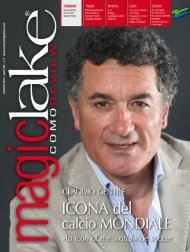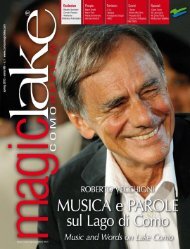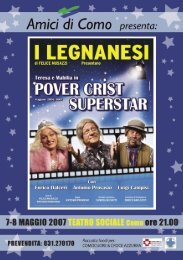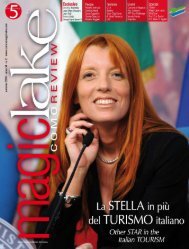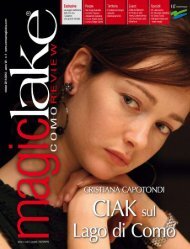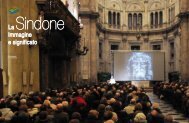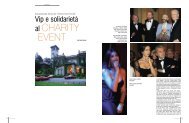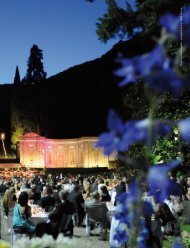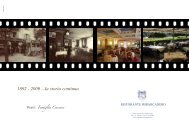Create successful ePaper yourself
Turn your PDF publications into a flip-book with our unique Google optimized e-Paper software.
RISTORANTE<br />
I TIPI TIPICI<br />
Alessandra, Lucio e Gloria<br />
Rossetti (nella fo<strong>to</strong> a sinistra) vi<br />
aspettano al Ris<strong>to</strong>rante, pizzeria<br />
con pasticceria “I Tipi Tipici” in<br />
via Baragiola 6. Per prenotazioni<br />
contattare lo 031.378641<br />
RESTAURANT<br />
I TIPI TIPICI<br />
Alessan<strong>da</strong>, Lucio and Gloria<br />
Rossetti 3 are waitinf for you<br />
at “I Tipi Tipici”, Restaurant,<br />
pizzeria and cake shop in<br />
Via Baragiola. To book dial<br />
031.378641<br />
ANTICA HOSTARIA<br />
MOLINA<br />
Prelibatezze <strong>to</strong>scane all’Antica<br />
Hostaria Molina di Simona<br />
Giorla e Gianan<strong>to</strong>nio (a<br />
destra nella fo<strong>to</strong>). Si trova in<br />
piazza Sant’An<strong>to</strong>nio 2/4. Per<br />
prenotazioni 031.309950<br />
ANTICA HOSTARIA<br />
MOLINA<br />
Tuscan delicacies at Antica<br />
Hostaria Molina owned by<br />
Simona Giorla and Gianan<strong>to</strong>nio<br />
(in the pho<strong>to</strong> on the right). It is<br />
in piazza St An<strong>to</strong>nio 2/4. To book<br />
dial 031.309950<br />
dicembre 1854, in San Pietro, a Roma. Tra i personaggi<br />
minori, ma non meno significativi, c’è poi tale Pietro<br />
Casarino, anch’egli di Molina, emigra<strong>to</strong> a Montevideo,<br />
dove ospitava conterranei in difficoltà. E la sua casa<br />
ha vis<strong>to</strong> soggiornare il futuro Eroe dei due Mondi,<br />
Giuseppe Garibaldi.<br />
A ques<strong>to</strong> pun<strong>to</strong>, dopo aver passeggia<strong>to</strong> nella s<strong>to</strong>ria,<br />
una sosta si impone. Molina può essere definita il<br />
paese delle tre osterie imperdibili, per i menu, per<br />
l’ambiente tipico, per il calore e lo zelo dell’accoglienza.<br />
Provate la Trat<strong>to</strong>ria di Pippi, nell’angolo a destra della<br />
chiesa di Sant’An<strong>to</strong>nio (16<strong>55</strong>), più volte rimaneggiata<br />
discutibilmente. Sulla piazzetta dedicata al san<strong>to</strong><br />
protet<strong>to</strong>re degli animali apre l’Antica Hostaria Molina,<br />
di Simona Giorla e Gianan<strong>to</strong>nio, con prelibatezze<br />
<strong>to</strong>scane, tra cui il vero lardo di Colonnata. Infine,<br />
trovate veramente tut<strong>to</strong> sul piazzale del parcheggio, <strong>da</strong><br />
Tipi Tipici, di Alessandra, Lucio e Gloria Rossetti. Non<br />
è soltan<strong>to</strong> ris<strong>to</strong>rante con veran<strong>da</strong>, è anche pizzeria, bar,<br />
tabaccaio, edicola e soprattut<strong>to</strong> pasticceria. Perché<br />
non portarsi a casa un souvenir dolce?<br />
Sot<strong>to</strong>, un vicolo<br />
di Molina<br />
Below, a<br />
Molina’s alley<br />
ac<strong>com</strong>mo<strong>da</strong>ted the future Hero of two worlds,<br />
Giuseppe Garibaldi.<br />
At this point – after going on a stroll through his<strong>to</strong>ry<br />
– you deserve a break. And Molina could be called<br />
the ‘three not-<strong>to</strong>-be-missed inns village’, because<br />
of the food on offer, their typical ambience, and the<br />
warmth and enthusiasm of the wel<strong>com</strong>e. Try the<br />
Trat<strong>to</strong>ria di Pippi in the corner <strong>to</strong> the right of the<br />
church of St. An<strong>to</strong>nio (16<strong>55</strong>), which has on occasion<br />
been subjected <strong>to</strong> some rather dodgy revamping.<br />
In the little square dedicated <strong>to</strong> the patron saint<br />
of animals stands the wel<strong>com</strong>ing Antica Hostaria<br />
Molina owned by Simona and Gianan<strong>to</strong>nio Giorla,<br />
with Tuscan delicacies including real Colonnata<br />
lard. And finally, you’ll really find the lot in the little<br />
parking square at Alessandra, at Lucio and Gloria<br />
Rossetti’s Tipi Tipici. It isn’t just a restaurant with a<br />
veran<strong>da</strong>h, but it’s also a pizzeria, bar, <strong>to</strong>bacconist’s,<br />
newsagent’s and (above all) a cake shop. Why not<br />
take a sweet souvenir home with you?<br />
OLTRE 3.000 ANNI<br />
DI STORIA<br />
La prima traccia scritta del nome Molina è in una<br />
Bolla di Papa Lucio III, del 1184. Ma fin <strong>da</strong>i tempi<br />
più antichi la zona era abitata, sicuramente <strong>da</strong>i<br />
Celti (1200 a.C. circa), e prima ancora sulle alture,<br />
in particolare nei pressi della fantastica Grotta<br />
Guglielmo, al Monte Bolet<strong>to</strong>ne, che merita una<br />
gita-escursione, sono state trovate punte di freccia<br />
che indicano la presenza dell’uomo preis<strong>to</strong>rico. Né<br />
mancano i famosi massi avelli, <strong>to</strong>mbe del V-VI secolo<br />
d.C. scavate nei trovanti, i macigni trascinati fin qui<br />
<strong>da</strong>i ghiacciai alpini e lasciati sul pos<strong>to</strong> <strong>da</strong>l loro ritiro<br />
con gli scioglimenti, sette volte, dovuti al rialzo delle<br />
temperature.<br />
Pur tra controversie, vis<strong>to</strong> che gli s<strong>to</strong>rici non sono<br />
tutti d’accordo, <strong>com</strong>e accade spesso, di queste parti<br />
era Frà Filippo, mor<strong>to</strong> nel 1416, uno dei più severi<br />
inquisi<strong>to</strong>ri che per secoli hanno imperversa<strong>to</strong> nella<br />
diocesi di Como, partendo <strong>da</strong>ll’allora conven<strong>to</strong> di San<br />
Giovanni in Pedemonte, oggi stazione delle Ferrovie<br />
dello Sta<strong>to</strong>. Scrive di Molina, infine, il celebre vescovo<br />
Feliciano Ninguar<strong>da</strong> nel suo meticoloso diario della<br />
visita pas<strong>to</strong>rale sul Lario e din<strong>to</strong>rni durata <strong>da</strong>l 1588<br />
al 1593.<br />
Un’ultima curiosità. L’orrido di Molina, a lago, nei<br />
pressi della nota Villa Pliniana, un tempo era det<strong>to</strong><br />
Grotta di Plinio (il Giovane) <strong>da</strong>l nome dell’umanista<br />
romano scopri<strong>to</strong>re della fonte che ha reso famosa la<br />
villa stessa. Nel XVI secolo era utilizza<strong>to</strong> <strong>com</strong>e luogo<br />
di frescura per pic-nic, frequenta<strong>to</strong> anche <strong>da</strong>l nobile<br />
Giovanni Anguissola, artefice della costruzione di<br />
Villa Pliniana.<br />
OVER 3000 YEARS<br />
OF HISTORY<br />
The first written trace of the name Molina is in Lucio<br />
III’s Papal Bull of 1184. But right back in ancient times<br />
the area was inhabited, certainly by the Celts (circa<br />
1200 B.C.) and even earlier on the high ground, in<br />
particular in the vicinity of the fantastic Guglielmo<br />
Grot<strong>to</strong> on Monte Bolet<strong>to</strong>ne – well worth an outing –<br />
arrow heads have been found indicating the presence<br />
of prehis<strong>to</strong>ric man. Then there are many of the famous<br />
sepulchre boulders, 5 th - 6 th century A.D. <strong>to</strong>mbs hewn<br />
out of erratic rocks, dragged all the way from Alpine<br />
glaciers and deposited here, as on seven different<br />
occasions the latter withdrew through melting caused<br />
by rising temperatures.<br />
Amidst controversy (seeing that his<strong>to</strong>rians aren’t all<br />
in agreement, as is often the case) Friar Filippo is<br />
said <strong>to</strong> have lived around here; he died in 1416 and<br />
was one of the harshest inquisi<strong>to</strong>rs who for centuries<br />
brutalised the Diocese of Como, setting out from the<br />
then Monastery of St. Giovanni in Pedemonte, now the<br />
State Railway station.<br />
Last of all there is an account of Molina by the<br />
renowned bishop Feliciano Ninguar<strong>da</strong> in his<br />
meticulous diary of this pas<strong>to</strong>ral visit <strong>to</strong> the Lario and<br />
district from 1588 <strong>to</strong> 1593. One last curiosity. The<br />
Orrido di Molina on the lake near the famous villa<br />
Pliniana, used <strong>to</strong> be called Plinio Grot<strong>to</strong> (the Younger)<br />
after the Roman humanist who discovered the spring<br />
and made the villa itself famous. In the 16 th century it<br />
used <strong>to</strong> serve as a cool, shady picnic spot, also visited<br />
by the noble Giovanni Anguissola whose brainchild<br />
the Pliniana was.<br />
54 <strong>55</strong>



